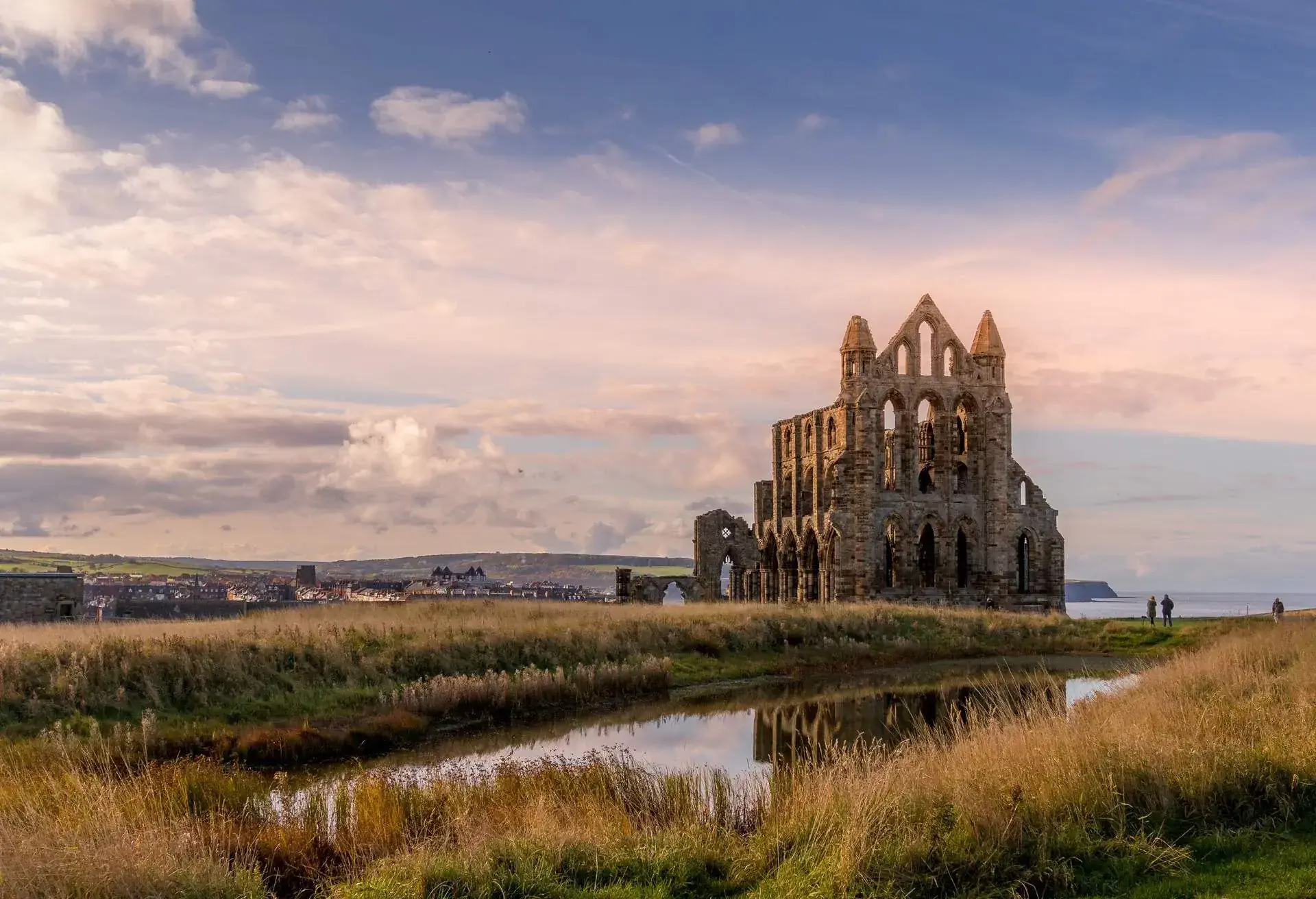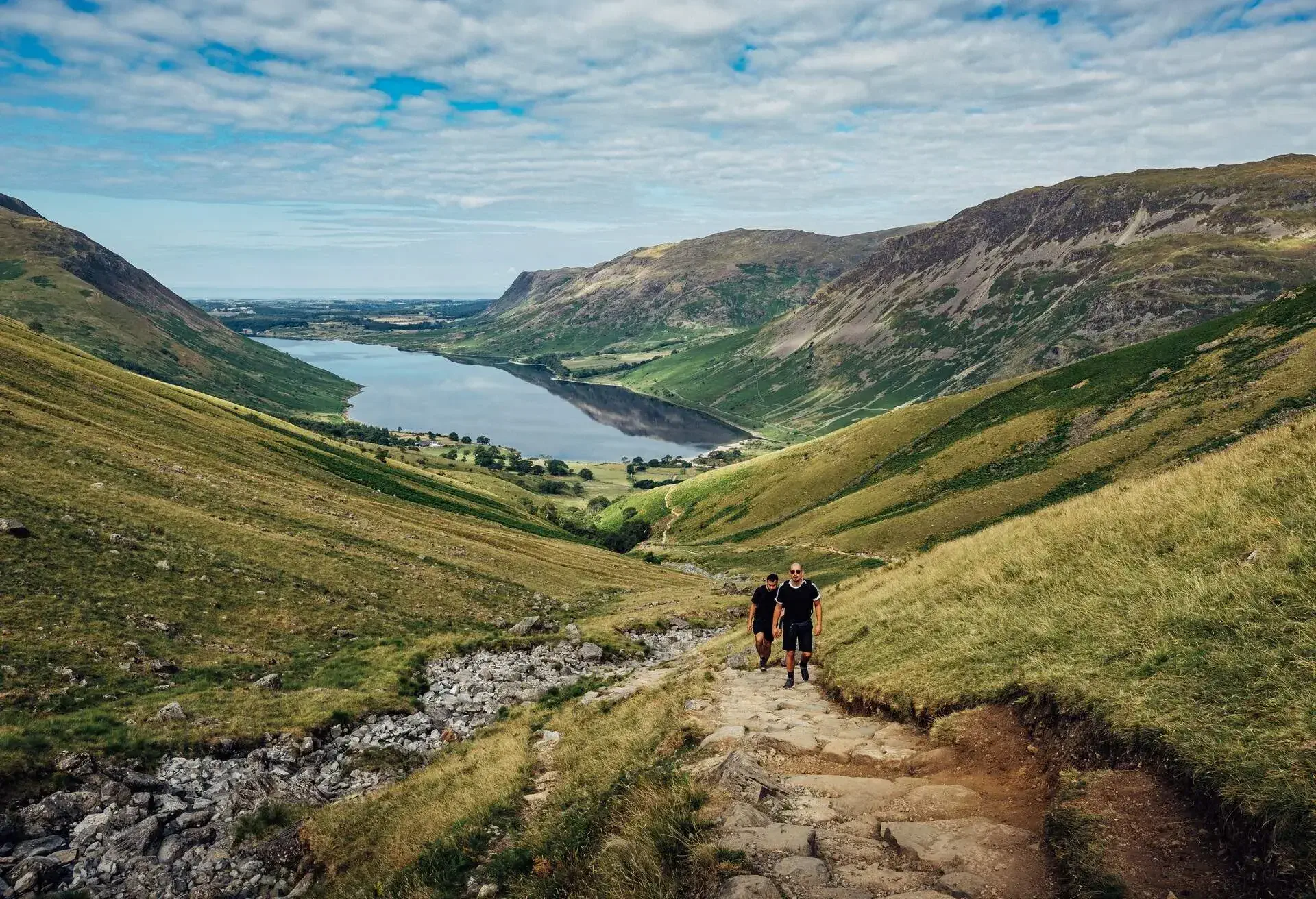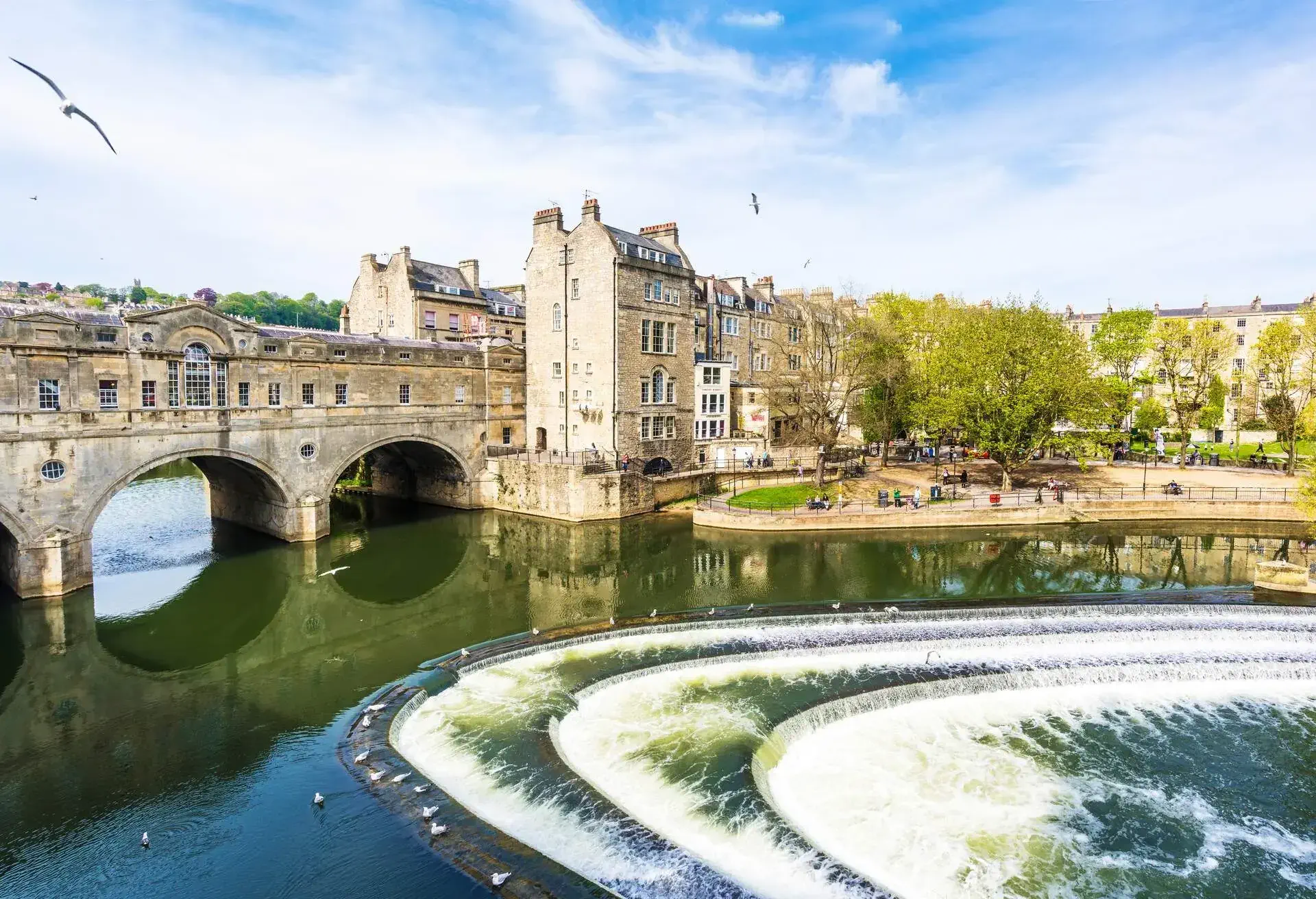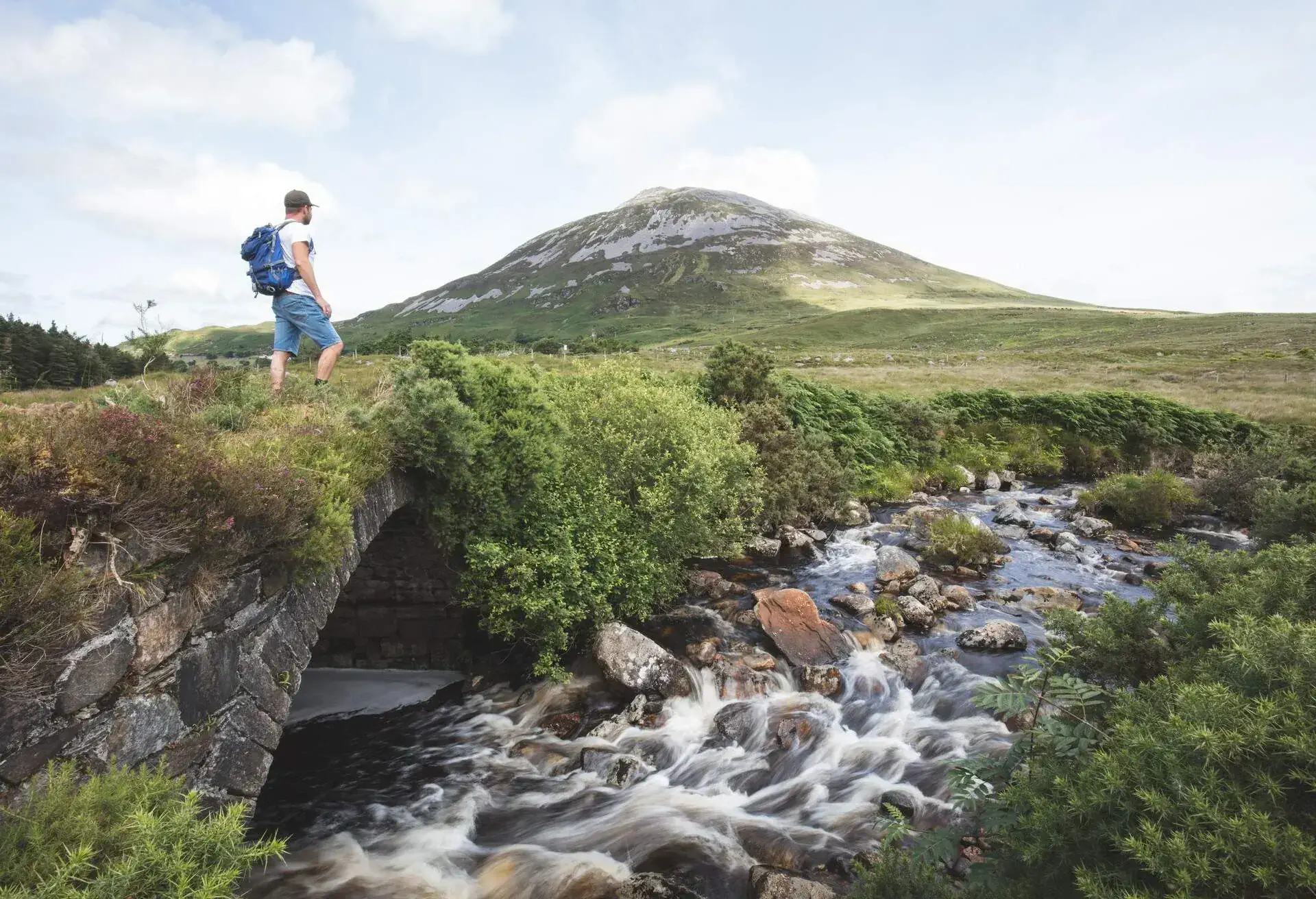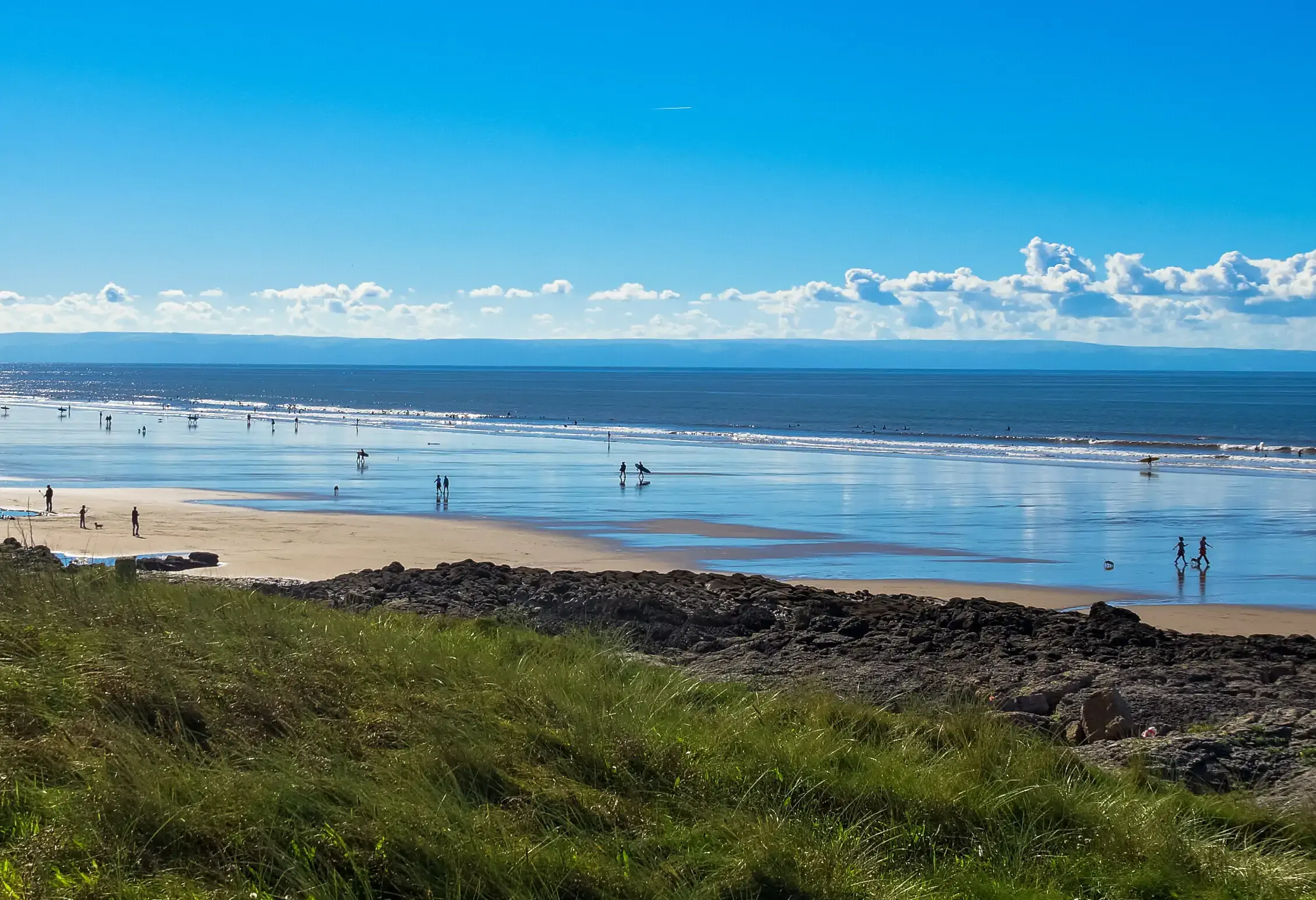If the pandemic has taught us anything, it’s to appreciate what travel opportunities we have on our doorstep. So often we’ve been used to jumping on a plane in search of an adventure. But now – even though foreign travel is back on the menu – many people are opting for staycations.
From a wealth of medieval structures and modernist architecture, ancient museums and designer boutiques, wild style and refined culture, secret beautiful places and cultivated gardens, natural wonders, and thriving cities; there are loads to see and do.
It’s easy to see why overseas sightseers are so attracted to Carnaby Street, Loch Ness, and Canterbury Cathedral. But here we have put together a list of places that tend to be found off the beaten track in Britain; some are relatively famous, some are forgotten by most, but all should be experienced at least once in a lifetime.
As we delved into researching this piece we realised how hard the job we’d created for ourselves was. The top 5 became the Top 10. The top 10 became the Top 15. And the Top 15 became, you’ve guessed it, 25. The 25 magic places to visit that we have chosen are steeped in history, be it natural or human, and all unforgettable.
Gasping at the Gaping Gill Cave, North Yorkshire

The Yorkshire Dales are all rolling meadows delineated by stone walls, pockets of water and castles, abbeys, and villages scattered over the stunning landscape, but perhaps the most remarkable feature to be found here is the Gaping Hill Cave. While most people may be familiar with the name, few have been here. Get a move on though, public access to the cave, via a winch, is only possible at particular times of the year. From May until June with the Bradford Pothole Club and in August with the Craven Pothole Club.
When to go: May or August, when local caving clubs organise a winch event where the public has the opportunity to be airlifted down the 360ft shaft.
How to get there: The best route is definitely by driving, located a short distance from the M1 and M6. You can also walk from the nearby town of Clapham.
Monkey around at the Cassiobury Farm and Fisheries, Watford

Zebras, flamingoes, wolves, and monkeys in the middle of Watford? You must be kidding. Nope. This is actually a big secret kept mostly between Watford’s locals. In the middle of Cassiobury Park – which is ranked as one of the best parks in the UK – you’ll find Cassiobury Farm and Fisheries. Hidden down a long track in the middle of a wood, you wouldn’t even know it was there until you see the procession of visitors on one of its open days. You better plan accordingly as this hidden gem is only open six days a year – but it’s well worth a visit.
When to go: Check the website for opening dates.
How to get there: Watford Junction train station is easily accessible from most parts of the country. The M25 junction is also just ten minutes away if you are travelling by car.
Go Wild on The Wild Atlantic Way, Ireland
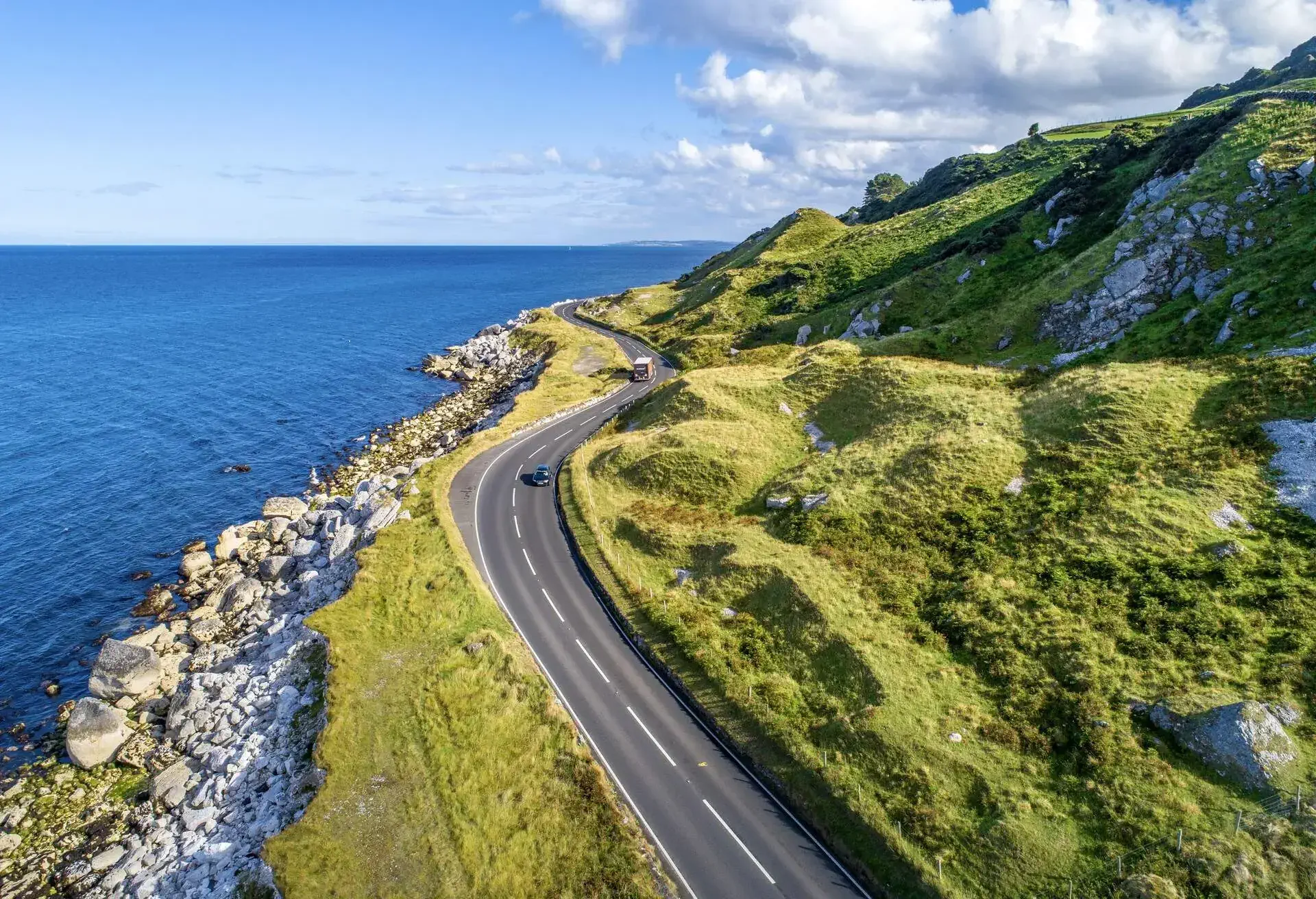
Move over Route 66, this jaw-dropping coastal route is one of the longest and most spectacular in the world. Stretching 1600 miles from County Donegal’s Inishowen Peninsula in Ulster to Kinsale, County Cork, in Munster, on the Celtic Sea coast, you’ll cover crazy inclines as you travel across nine counties. You’ll need at least two weeks, preferably three, to get the most out of your trip so pack up your car (or motorhome) for the journey of a lifetime. There are 150 ‘Discovery spots’ to see, with another 15 highlighted as ‘Signature Discovery Points ‘ so in advance it’s worth deciding where you want to stop off. Atlantic Drive has been named one of the most scenic stretches of coastline in the world. There are rocky headlands, high cliffs, and blow holes where you can see the water shoot out of.
When to go: The summer showcases the landscape at its best.
How to get there: There are daily ferry services between Ireland and UK. Or you could fly into Cork airport from most major cities.
Be alone on Balevullin beach, Isle of Tiree

The Isle of Tiree has some of the best beaches you could ever wish for, but this is our pick. Perfect white sands, with no one photobombing your photos, except maybe seals, otters, and basking sharks. You’ll need to travel to the Inner Hebrides of Scotland but if you want to get away from it all and have your own Leonardo DiCaprio Beach moment, this is your place. Located on the northwest corner of the Isle of Tiree, this mile-long beach rarely gets busy, with the exception of water sport enthusiasts enjoying the fantastic waves from the Atlantic.
When to go: The summer as the winters are harsh.
How to get there: Ferries run from Oban on the mainland once a day.
Zone out in Boscombe, Dorset
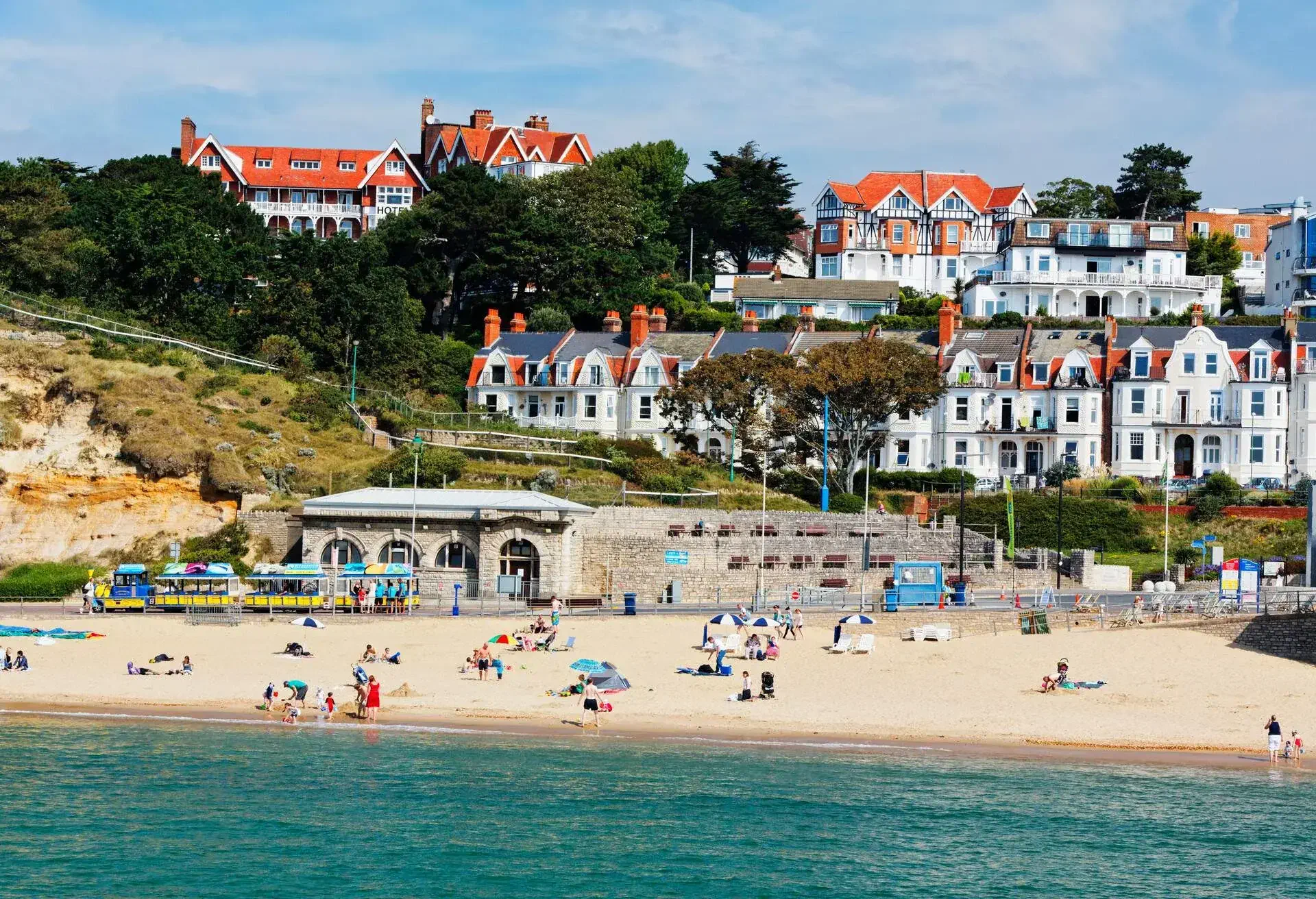
In the shadows of its famous neighbour Bournemouth, Boscombe beach is often overlooked. But it’s a much more beautiful and chilled option if you fancy a short stay at the seaside. Children will love the long stretch of beautiful sand which is a superb place for building sandcastles and flying kites.
Yoga lovers will enjoy the daily schedule of activities in the warmer months while surfers will appreciate the waves from October – March. Cars are only allowed on the promenade for one hour a day so visitors are required to park on the top of the cliffs above and walk down. There isn’t a lot in the way of food options other than a small beach cafe and a few other eateries at the end of the promenade so bring a picnic and enjoy the beauty of Boscombe.
The nearby Chine Botanical Gardens – including a mini golf course – are a delight too.
When to go: May – September.
How to get there: Take the M3 and M27 from the north or the A30/35 from the west. Pokesdown is the nearest train station, which is accessed from Waterloo and Woking.
Tyneham ghost town
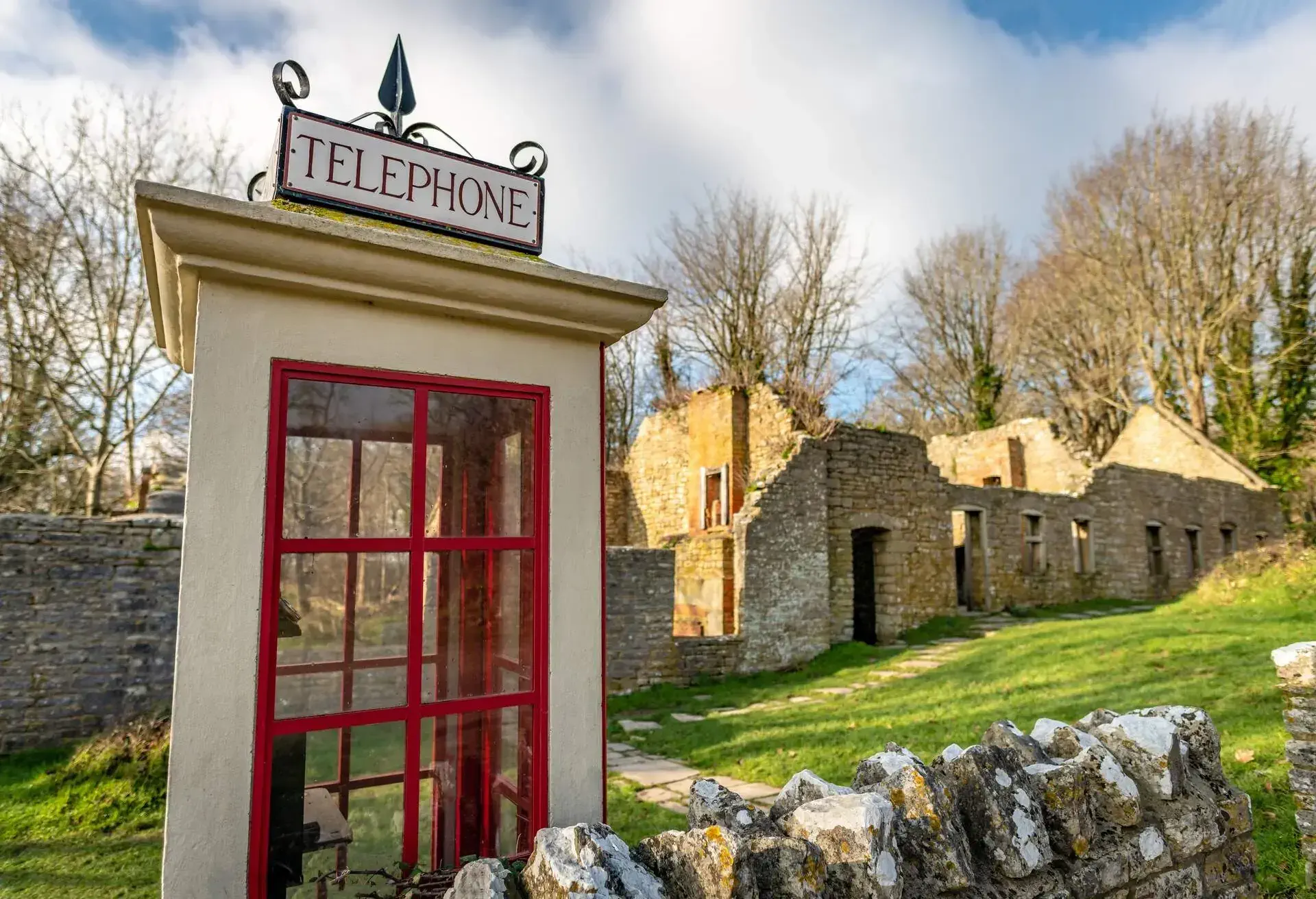
The village – often referred to as Dorset’s ‘lost village’ – was inhabited from Iron Age Times until it was evacuated in December 1943 during WWII.
The Ministry of Defense used the area as a firing range and residents were never allowed to return. Of the 225 people displaced the last left this note on the church door:
“Please treat the church and houses with care; we have given up our homes where many of us lived for generations to help win the war to keep men free. We shall return one day and thank you for treating the village kindly.”
But they never did. These days the village and designated footpaths across the range are open to the public on weekends and for longer periods during the summer. With the village slowly crumbling into ruin, there is an eeriness that feels like all time stopped here back in 1943.
Some of the outbuildings have now been restored and there is an area for picnics.
When to go: The village is open to the public at weekends and public holidays.
How to get there: Tyneham is in Purbeck, but because it is uninhabited there is little in the way of directions, nor does it have a postcode. Click here for more information on how to get there from the nearby towns of Weymouth, Poole, and Bournemouth. No coaches are allowed.
Loch Awe, need we say more?
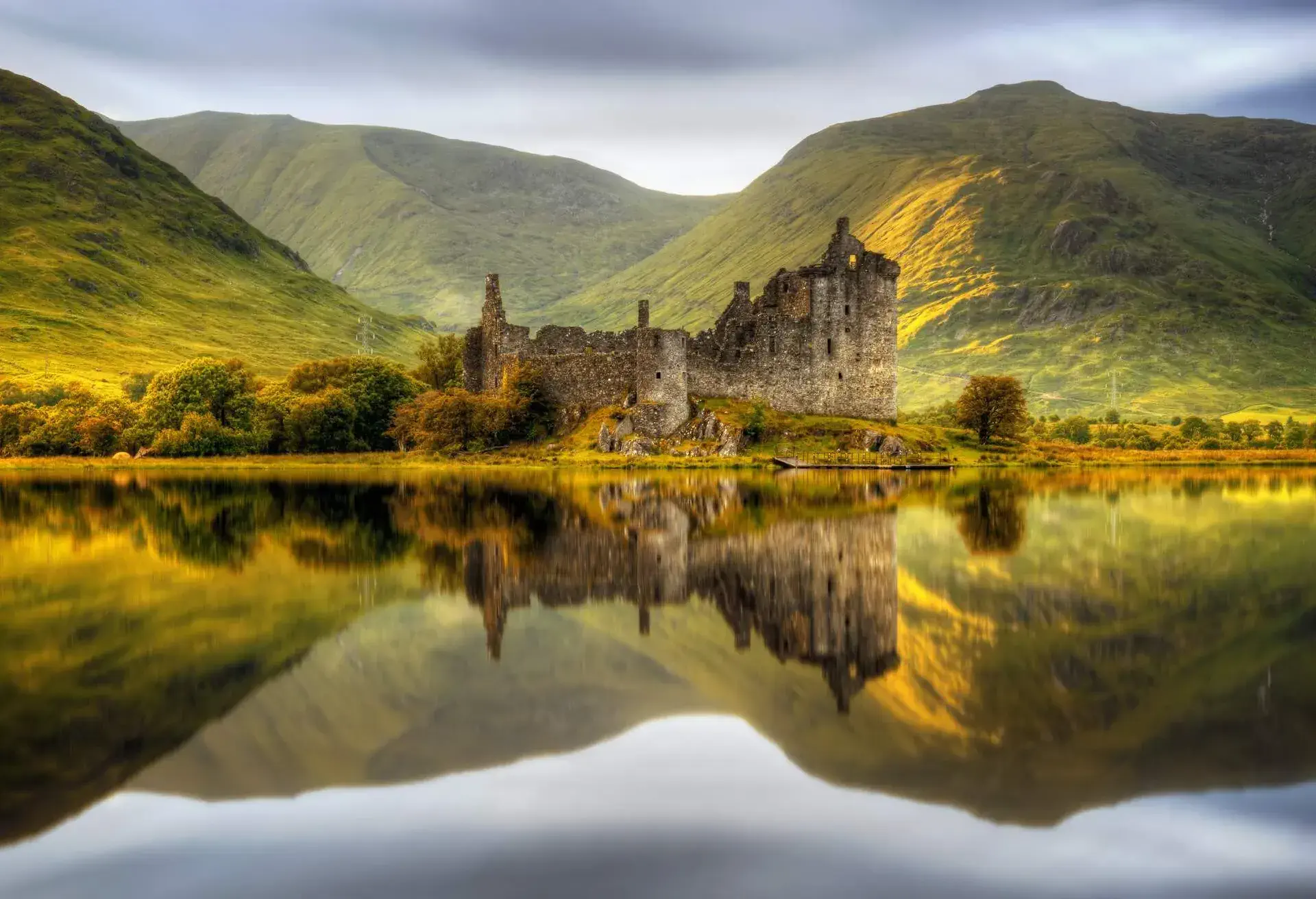
With a name like Loch Awe, you’d be right to have high expectations. And thankfully the third-largest freshwater loch in Scotland doesn’t disappoint. Between the various castle ruins, including the you-must-know-it-at-least-from-the-telly, Kilchurn Castle, and the world-class trout fishing, this Loch doesn’t need an imaginary (or is she?) monster to fill you with a sense of ….wonder?
When to go: May – September is the best time to visit as you have the best chance of glistening sunshine on the Loch.
How to get there: You can fly or get the train to the nearby city of Glasgow, and then catch the ScotRail towards Oban. Or if you’re driving take the A82 from Glasgow.
Treasure the moment on St Ninian’s Isle, Shetland, Scotland
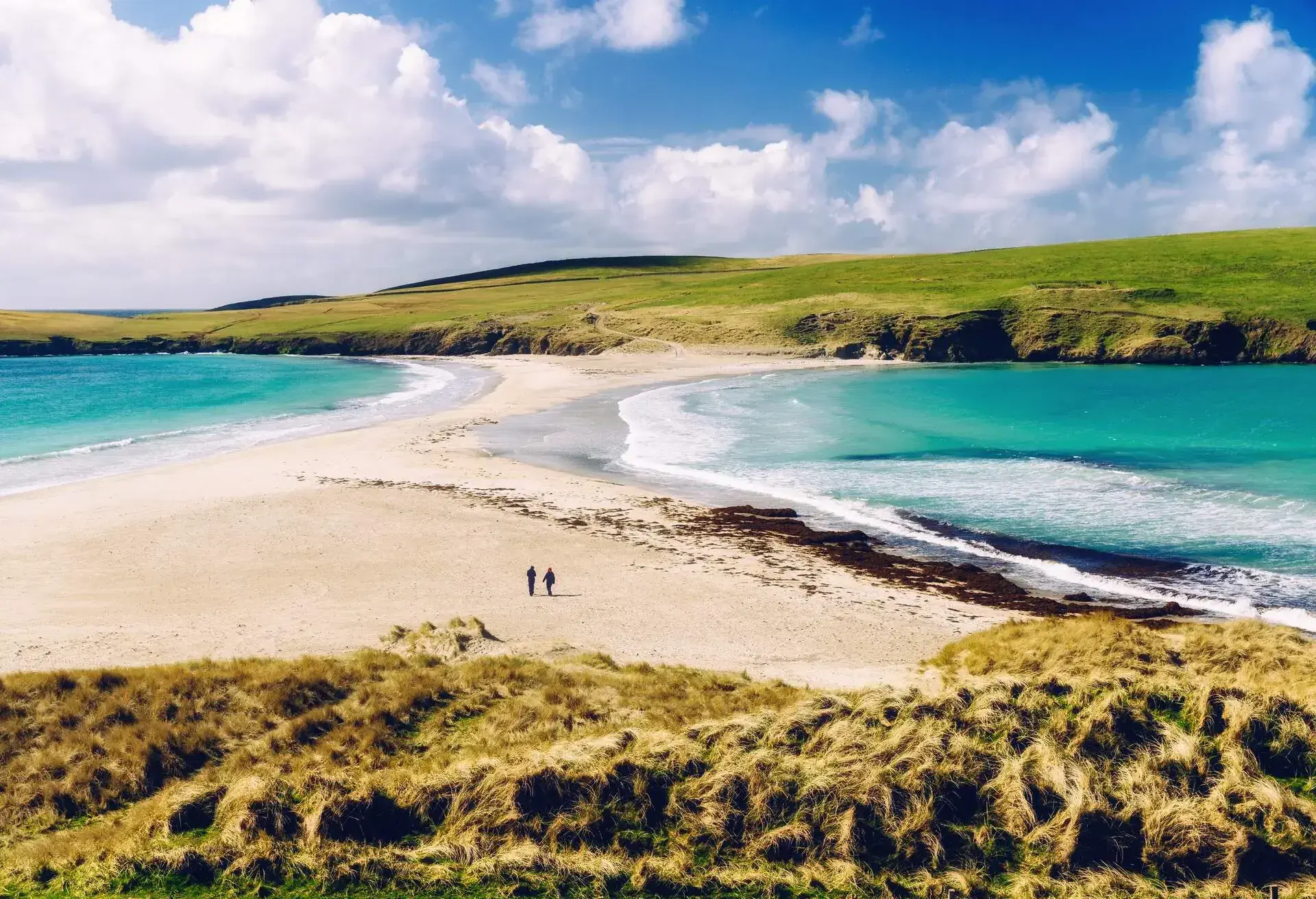
Scotland has been consistently voted the most beautiful country in the world, and we definitely know why. The largest natural tombolo (a bar of sand that joins an island to the mainland) takes you from the west coast of Shetland to the postcard-perfect island of St Ninian’s. Visitors can walk along the 500m golden sand causeway to reach the island with stunning cliffs and the remains of St Ninian’s Chapel, which is famous for its ‘treasure’ of bowls, weaponry, and jewellery which as found when it was excavated in the 1950s.
When to go: April – October for the dryer weather. However, if you want a chance to see the Northern Lights then the best time to visit is between October and March when the nights are darkest.
How to get there: Get the ferry to Shetland and then enjoy the 500m walk across the sand pathway.
The most beautiful of all? Bilbury, Gloucestershire
With its exquisite 17th-century stone cottages with steep roofs, 19th-century artist William Morris called Bibury “the most beautiful village in England” when he visited it. The Cotswolds is a popular weekend break away but many miss out on visiting this wonderful little village on the River Coln. Alongside the honey-coloured Arlington Way properties, the village’s trout farm is an interesting day out, plus there are many fantastic walking routes to enjoy. You’ll find an array of wonderful brasseries and outdoor drinking spots too.
When to go: The spring.
How to get there: Located less than two hours from London, the village is located just off the A40 if you are travelling by car. The nearest train station is Kemble, 14 miles away.
Margate Shell Grotto: A British mystery in Kent

Underground tunnels filled with intricate patterns of 4.6 million shells can be found underneath a residential street in Margate. Discovered in 1835, to this day, no one knows the purpose of the subterranean passage. Featuring an incredibly detailed mosaic of suns, stars, and geometric patterning, there is even a skylight, which indicates the designers were well ahead of the times.
With its rotunda and the central altar, hypotheses range from a prehistoric astronomical calendar to secrets rooted in the occult dealings of the Knights Templar or Freemasons. If you need to shake the uncanniness of the place, there is a museum, shop, and café attached to that, as well knowing the folklore of the place is home to Flossie the shell dinosaur.
When to go: It’s inside so not weather dependent. However best to avoid weekends and school holidays as the Grotto is only small.
How to get there: It’s a five-minute walk from the centre of Margate. Located on the east coast of England, you can drive via the M2 or M20.
The Dark Hedges: A road fit for a king in County Antrim
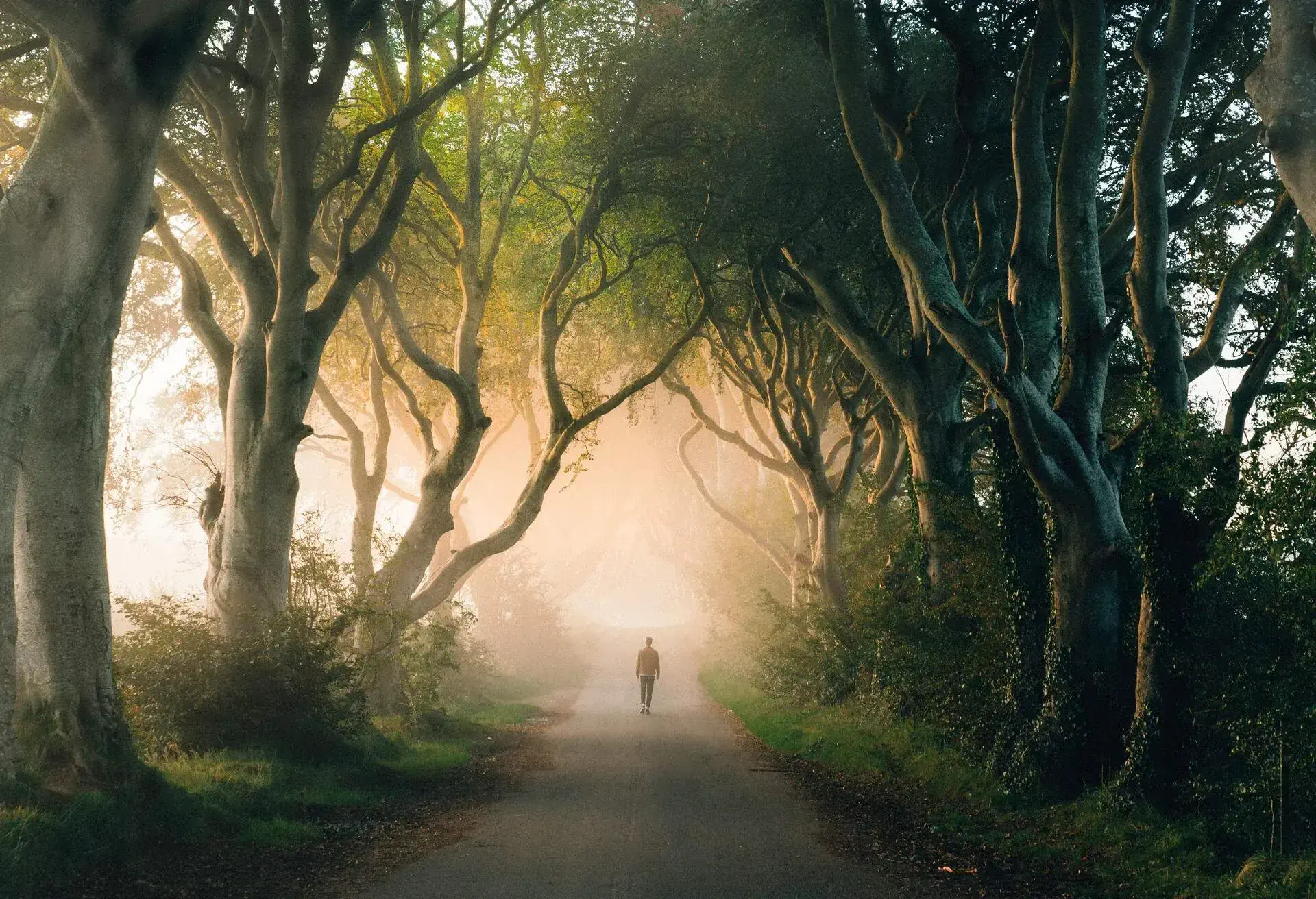
Ok, so most fantasy fans are going to recognise County Antrim’s The Dark Hedges from a short but important role in that TV series with the Dragons. Yes, the one with all the nudity and colourful weddings. But even if you’re not a Game of Thrones fan it’s likely you’ve seen an image of this incredible avenue of ancient beech trees somewhere as its a popular location for TV and adverts. Even better it’s only a 20-minute drive from the Giant’s Causeway so there is even more reason to visit. Just keep your eyes peeled for the ghost of the Grey Lady…..
When to go: If you want to experience the Dark Hedges without the crowds arrive before 9am. Weather patterns around Lough Neagh suggest mid-spring to early autumn is best for trips to the area.
How to get there: You can fly to Belfast from most major cities or get the car ferry from Liverpool.
Over Owler Tor: Discover the best view in the Peak District
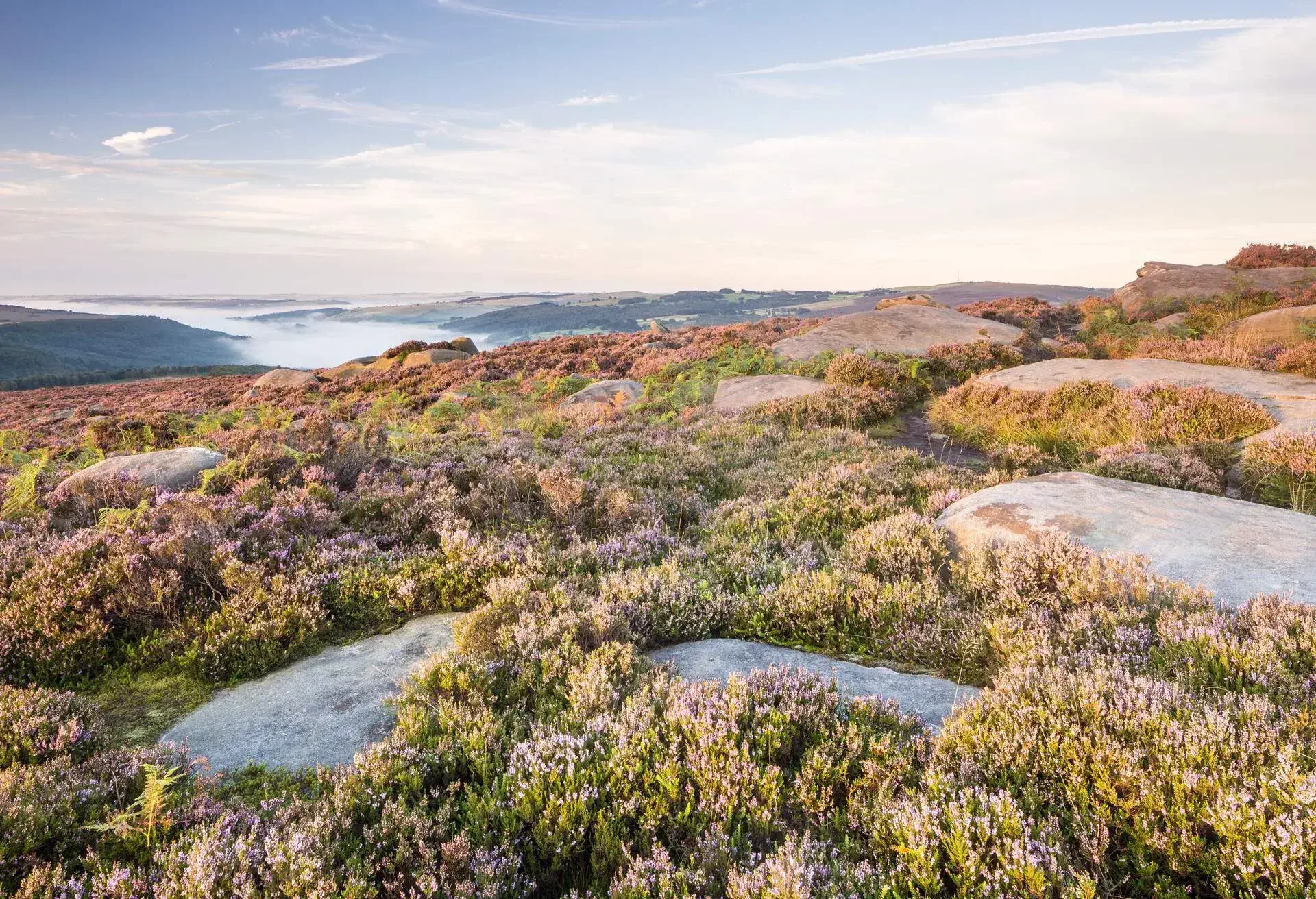
The whole of the Peak District in Derbyshire is stunning and there is a multitude of reasons to visit, but let’s tighten the lens a little bit and bring the focus to Owler Tor. You’ll need to park in Surprise View car park and hike up to reach it but believe us, it’s worth the trip.
The eroded gritstone formation that caps the hill is equally beautiful when seen in the new snow or an abundance of heather. If you can catch a moment here free from other people you’ll feel like you’re standing here before the dawn of time.
When to go: Anytime.
How to get there: Take the A61 from the M6 if coming from the south of England. Alternatively, Owler Tor is a short drive away from the nearby town of Sheffield. Grindleford is the nearest train station.
Norfolk Nights and Norfolk days in a purple haze

Get your camera ready, there’s heather and lavender aplenty to pose in here! Norfolk Lavender‘s distilleries, tearooms, gift shops, animal garden, and plant centre are all delightful in their own right, but, of course, it’s the gardens you are mostly there to see. Fields of lavender stretch as far as the eye can see and that delicate fragrance permeates the air around you. Bliss.
When to go: Between mid-June and mid-August if you want to see the lavender at its best.
How to get there: Located. a short distance from the M11, you can then take the A149 for three miles. The nearest train station is the Fox and Hound.
The Isles of Scilly: Contrasts off the coast of Cornwall
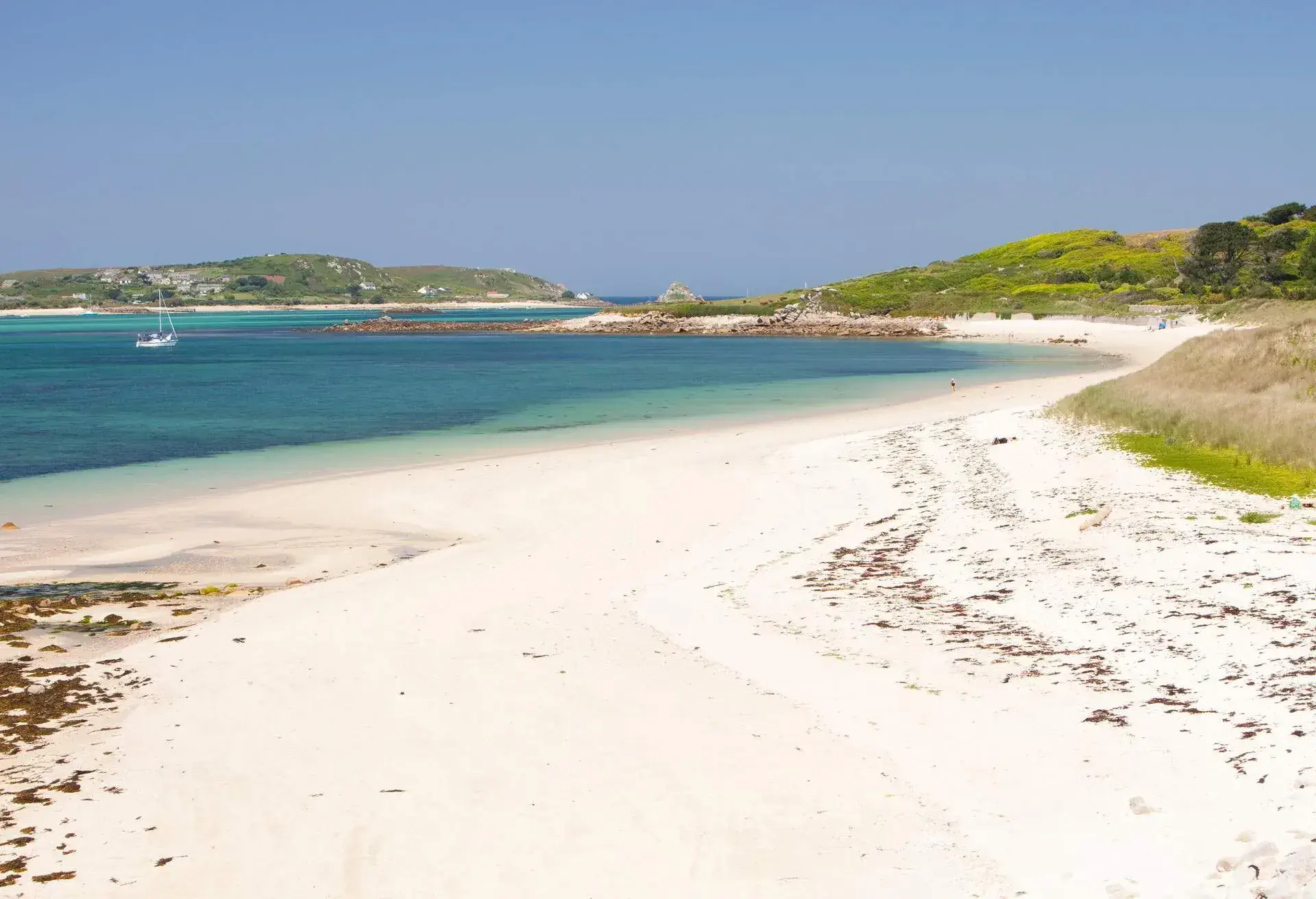
This archipelago off the Cornish coast is its own goodie bag of contrasting treats. Spread across the islands are cafés, restaurants, bars, craft shops, and galleries, etc, all of the highest quality. If you are after adventure, you can swim, dive, sail, kayak, windsurf, paddle board, horse ride, and bike to name a few of the fun activities on offer.
But the real magic of Scilly is how unique each island is. St. Mary’s is the gateway to the other islands and as close to ‘bustling’ as you’re going to get here with its population of 1,800. With a surface area of only 2.5 square miles, St. Mary’s is chock-a-block with beaches, coastal walkways and its two towns boast top eats and arts.
St. Martin’s has those perfect beaches you normally associate with postcards from the pacific, considered by many to be the best stretches of sand in Britain. The island also has an artisanal bakery, vineyard, flower farm, and silversmith.
Bryher is rugged and wild and watching the waves thunder into Hell bay is exhilarating, while on the other side of the islands the beaches couldn’t be more serene.
St. Agnes is untamed and littered with history, while there is a small community inland, you’ll feel like you’ve stepped back in time as you explore the island’s mounds, cairns, and bronze-age standing stones.
Live like a King at Tresco Abbey Garden, Isles of Scilly

Fully deserving of its own ranking is Scilly’s sub-tropical gem, Tresco which is akin to Kew Gardens but without the huge buildings and bragging rights. Nicknamed the Cornish Caribbean, the tiny island is located 28 miles from the mainland. King Charles inherited the island when he got his Duke of Cornwall title and owns a house near the gardens, where you’ll find 20,000 plants from countries such as Brazil, New Zealand, Burma, and South Africa. It truly is a plant lover paradise with meandering pathways through an array of colourful exotic flowers and towering palms. Nature lovers will also love spotting the red squirrels and golden pheasants that live there.
No cars are allowed on the island – with the exception of service vehicles – so there is a real feeling of calm and cleaner air everywhere you go.
You’ll also find pristine beaches, culinary flair, ancient burial sites, and castle ruins on the beautiful island.
When to go: Scilly has a mild climate and the most sunshine in the UK so you can explore at almost any time of the year.
How to get there: Boats run regularly from the mainland but you can also get a helicopter if you’re feeling flash.
Stacks of Duncansby: Scotland’s sentinels
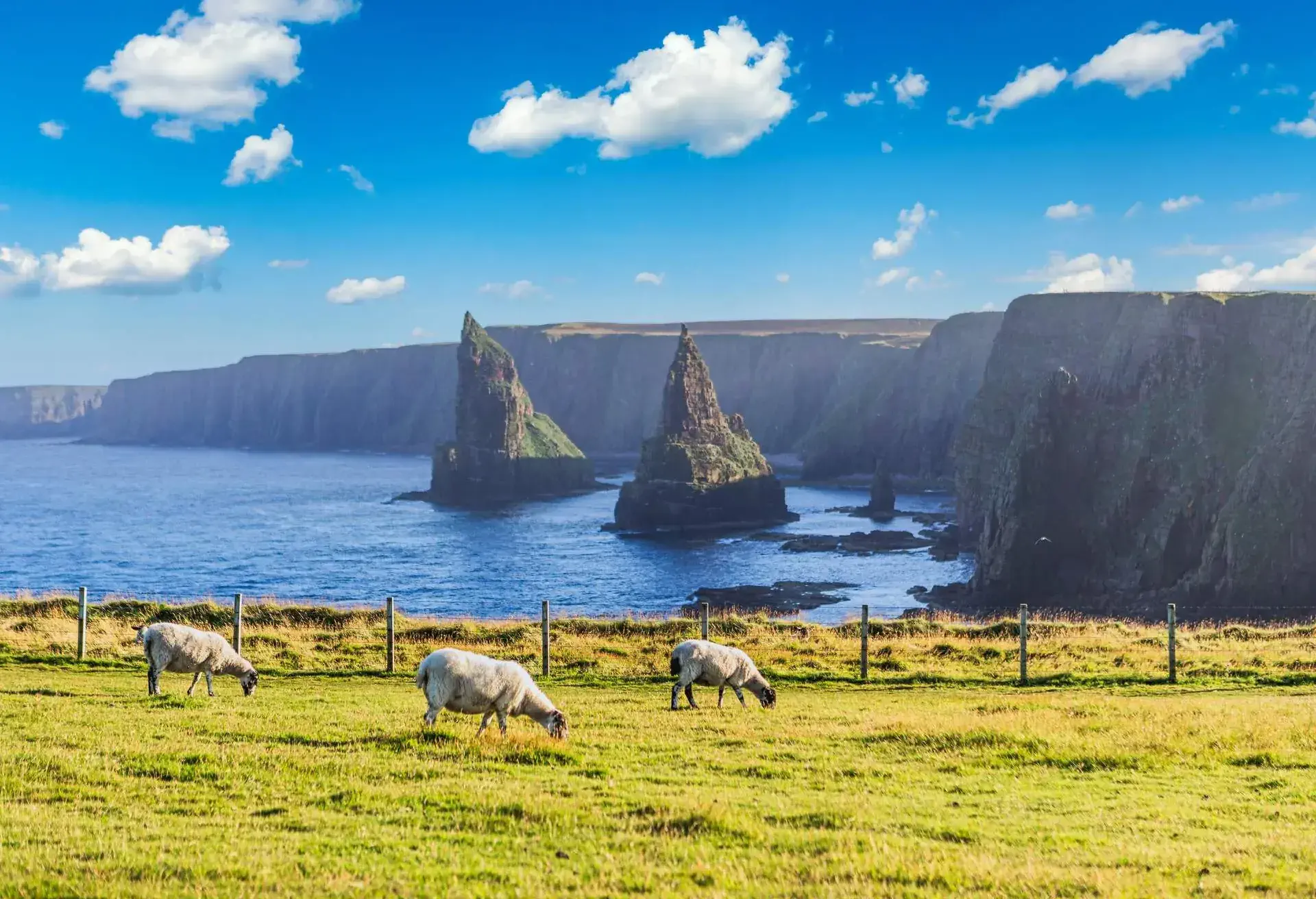
Each year hordes of tourists from around the world head to John O’Groats, a small Scottish village in the highlands that is famous for being Britain’s most north-eastern point. As can happen when a place becomes an almost mandatory stop-off for every tour bus operating in the highlands it’s easy to be cynical about the destination and not even consider stopping by yourself. But you should.
Not so much for the town itself (although, there is still plenty to do here), but as the setting out point for a walkout to Duncansby Head. On your walk, you’ll skirt rugged beaches, cross turf and bogs, pass through a kissing gate or two and stop at the lighthouse to catch a view out over the waves below before reaching your destination. Pictured above, the Stacks of Duncansby rise from the ocean floor and stand like sentinels at the end of the world. You can’t see them without feeling like you have a new appreciation of Mother Nature.
When to go: August or September is a great time.
How to get there: By car, travel from Inverness on the A9 to Latheron in Caithness and then take the A99 to ‘the end of the road’. The nearest airport is Wick or Inverness, where you can get a bus to John O’Groats.
Avebury Stone Circle: Hanging out in a henge
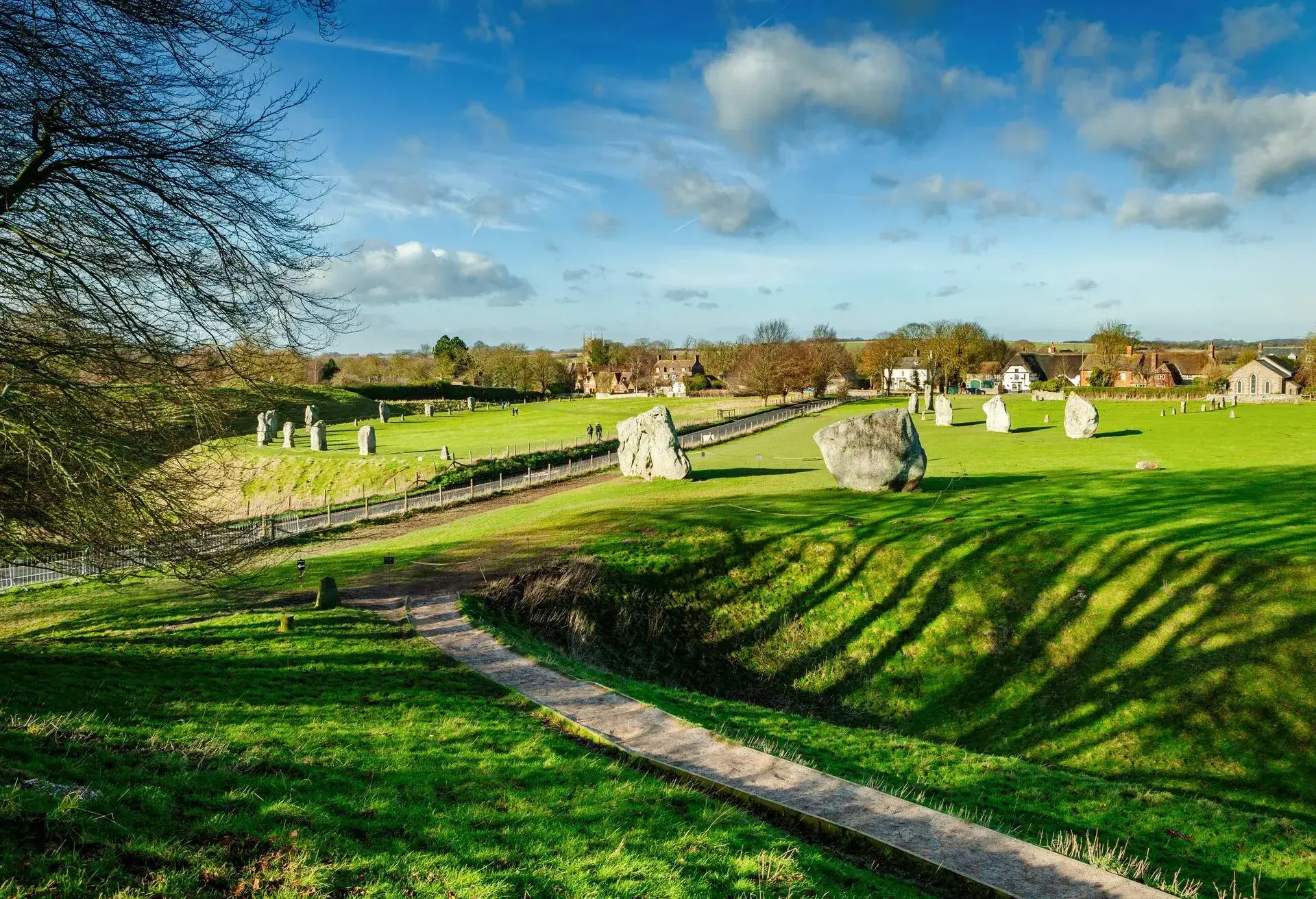
Stonehenge! It’s amazing! It’s also jammers with tourists and you have to maintain a very healthy distance from the of-so-famous stones. The three stone circles that make up the neolithic henge that surrounds the village of Avebury in Wiltshire, are fully accessible to the public and are in many ways even more compelling. Maybe it’s because the Avebury Stones are older, and larger and all of their mysteries are that much more palpable when you can get up close and personal with them.
When to go: Midweek, during the school term. Arrive early for the least crowds.
How to get there: Take the A303 from the M3 if coming from London or the north. It’s also not far from Bristol, Bath, and Exeter. There is a bus from Salisbury train station to Stonehenge.
Hellfire Caves, Wycombe: I bring you fire
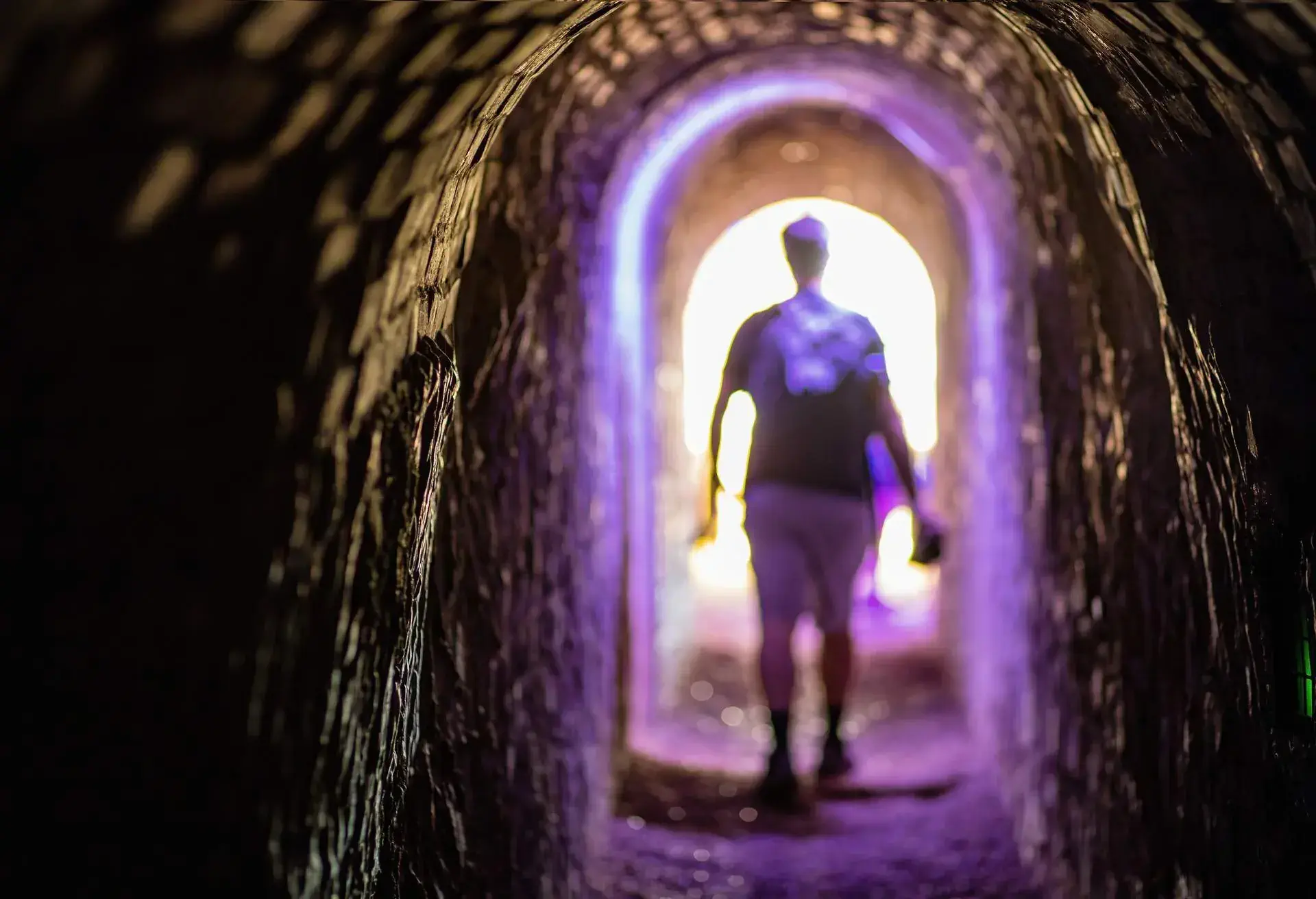
Deep in the Chiltern Hills, in the sleepy village of West Wycombe, underneath St. Lawrence’s Church, something ominous lurks. Entering through a striking archway, designed in the style of a gothic church, you’ll encounter nearly a mile of tunnels. Here various social and politically important 18th-century figures used to gather to practice occult rituals, drink heavily, and peruse saucy reading material.
No, this isn’t the plot to a BBC Drama, this is The Hellfire Caves, where the Hellfire Club used to meet. The Hellfire Club was a notorious group of publicly respectable men who secretly practised such untoward behaviour. Discover the caves yourself, just make sure the mischievous spirits of the “gentlemen” who used to meet there don’t possess you.
When to go: Halloween, when it’s super spooky.
How to get there: The caves are located in the town of High Wycombe which is located off the M40. There is a train and bus station nearby.
Fingal’s Cave, Staffa, the Inner Hebrides: Symphonic seclusion

The uninhabited island of Staffa is home to Fingal’s Cave. An awe-inspiring sight as you approach by boat, the basalt columns that frame the mouth of the cave rise like organ pipes around this natural wonder. Cathedral-like in nature and blessed with the acoustics to support this claim, the remoteness of this island is equally sobering and uplifting in its remoteness. There is a range of tours available out to Staffa and the surrounding islands but the light is best in the morning and if the weather is on your side you will be able to land and hear a natural symphony as the Atlantic thunders over the caves columns.
Fingal’s Cave was first made famous to a wider audience after it served as the inspiration for Felix Mendelssohn’s ‘Hebrides Overture (Fingal’s Cave) after he experienced the perfect acoustics for himself while exploring the Hebrides with friends in 1829. Just have a listen to the overture while checking out the above photo and try not to want to rush off to the Hebrides right away.
When to go: April – June and also September for the driest weather.
How to get there: Boat trips run from Oban, Mull, and Iona to Staffa. Turus Mara tours also offer courtesy bus runs from Craignure and Tobermory every day too.
Take in the Queen’s View, Pitlochry
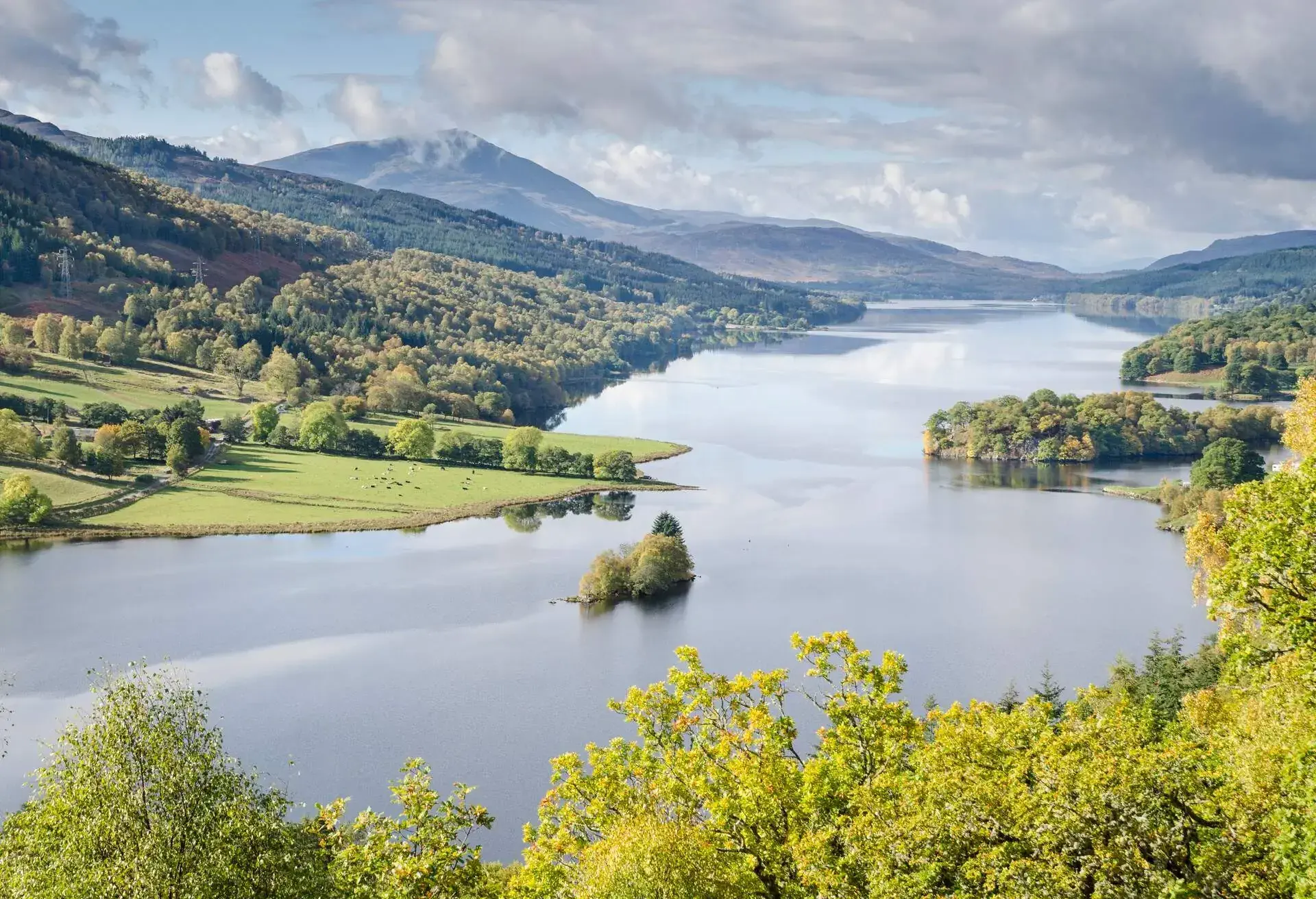
Just one look, and you’ll realise this is a very special place. When Queen Victoria visited in 1866 she thought the amazing view west along Loch Tummel was named after. However, it was said to be actually after Robert Bruce’s first wife Isabella, 500 years earlier. Awkward!
Pack up a picnic and admire the view of Tay Forest Park over a lazy lunch, it really is an incredible photo opportunity.
Best time to go: March-June when the trees are in full bloom, the weather is mild and the crowds are smaller.
How to get there: It’s definitely best to drive if possible. Take the A9 from the nearest major town of Perth. If you are reliant on the train, go to Pitlochry and then catch the bus.
Greyfriars, Edinburgh: Hauntings on hallowed grounds

If you’ve been to Edinburgh, chances are you already know about Greyfriars Bobby. You know, the cute dog statue that commemorates the sad story of a dog, Bobby, that slept at the grave of its master until Bobby passed on. Opposite the cute dog statue on George IV Bridge is the graveyard where Greyfriars Bobby is actually buried, as well as his owner John Gray, but that’s as far as the cute goes. The graveyard in question is Greyfriars Kirkyard, which has a long and terrifying history that will scare even the most hardened of ghost hunters. We’re not talking about your average sepulchral spooks. No, we’re talking about mass imprisonment and execution in a walled off section of the cemetery called ‘The Covenanter’s Prison’, mortsafe cages laid over the graves to deter body snatchers, a popular pursuit in the 18th century.
The graveyard is popular with Harry Potter fans too as author JK Rowling is believed to have sought inspiration for her best-selling books during numerous visits.
When to go: It’s a popular spot on Halloween for obvious reasons.
How to get there: The graveyard is in the centre of Edinburgh which is easily accessed via major train routes. There is also an airport and major motorways.
St Michael’s Mount: A ‘beanstalk’ lives underwater
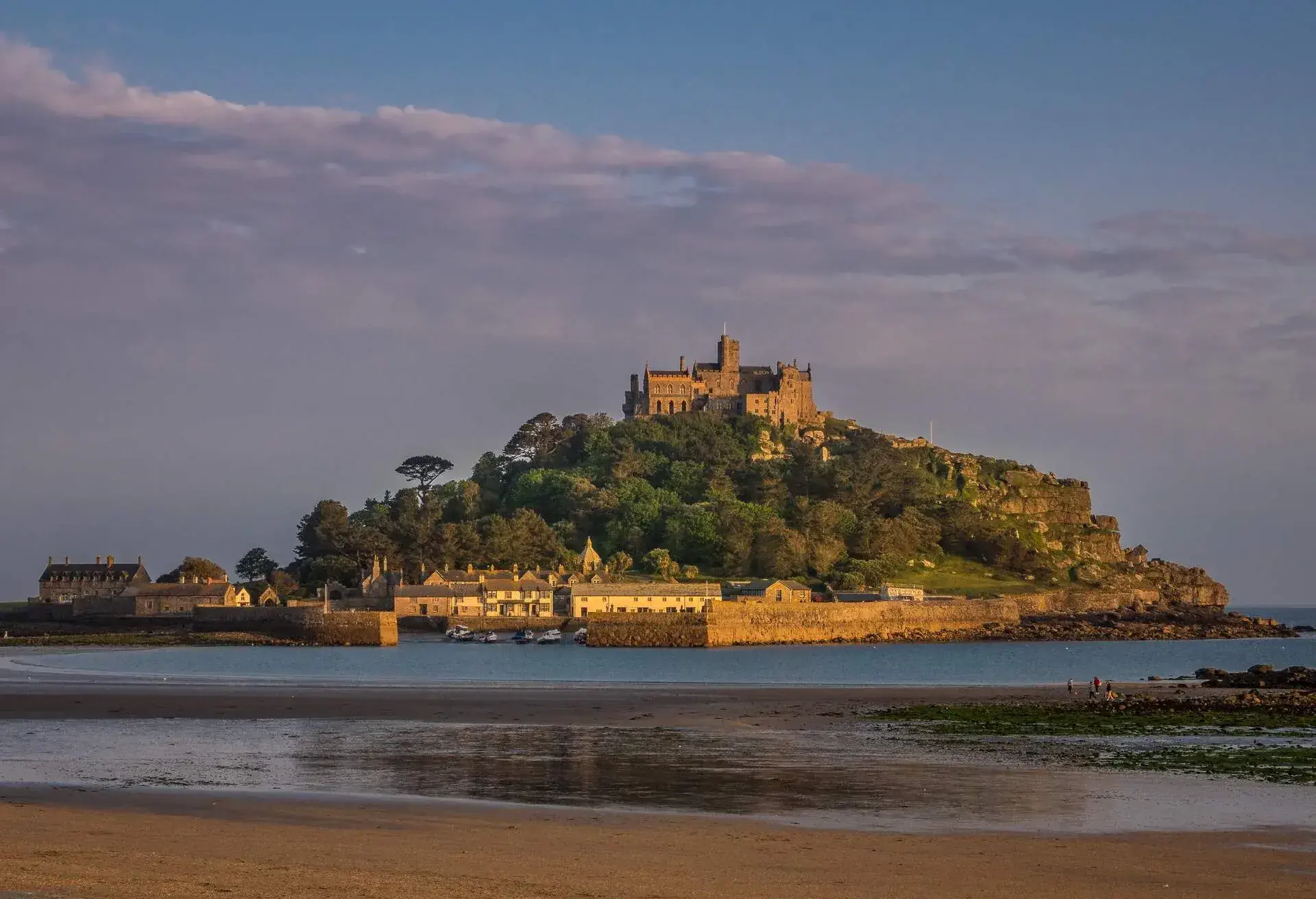
Located off the coast of Mount Bay, Cornwall, St. Michael’s Mount is one of the few tidal islands in the UK that visitors can walk to. Take note, unless your idea of a good time is being swept out to sea, the island is only accessible by foot during low tide. This small unassuming island has a rich history ranging from famous religious visions to strategic wartime capture. It’s also the source of the fairy-tale ‘Jack the Giant Killer’, as it was rumoured a giant lived on the island before a plucky local named Jack slew him.
When to go: April – September are the driest months with the lowest tide.
How to get there: From North Cornwall take the A30 or get a train to Penzance and take the bus. If you’re arriving at high hide you will need to take a boat from the town of Marazion as the causeway will be submerged.
Sgwd Henrhyd (Henrhyd Falls), Wales: Do go chasing…

In Wales, on the western edge of the Brecon Beacons is the South’s highest waterfall, a real feast for the eyes, especially after heavy rainfall. The walk to the waterfall winds through steep tree-lined gorges and if you approach quietly you may catch glimpses of kingfishers, wrens, and warblers darting through the valley. Sgwd Henrhyd cascades over the lip of farewell rock and falls 90ft (27m) into the wooded gorge below. The other walkways through surrounding Graigllech Woods and along the Nant Lech river are also stunning.
When to go: During the wetter winter months when the waterfall is at its best.
How to get there: Take the M4 to Newport and then the A467 around the southern edge of the Brecon Beacons. The nearest train station is Neath.
Whitby Abbey: A bloody good time
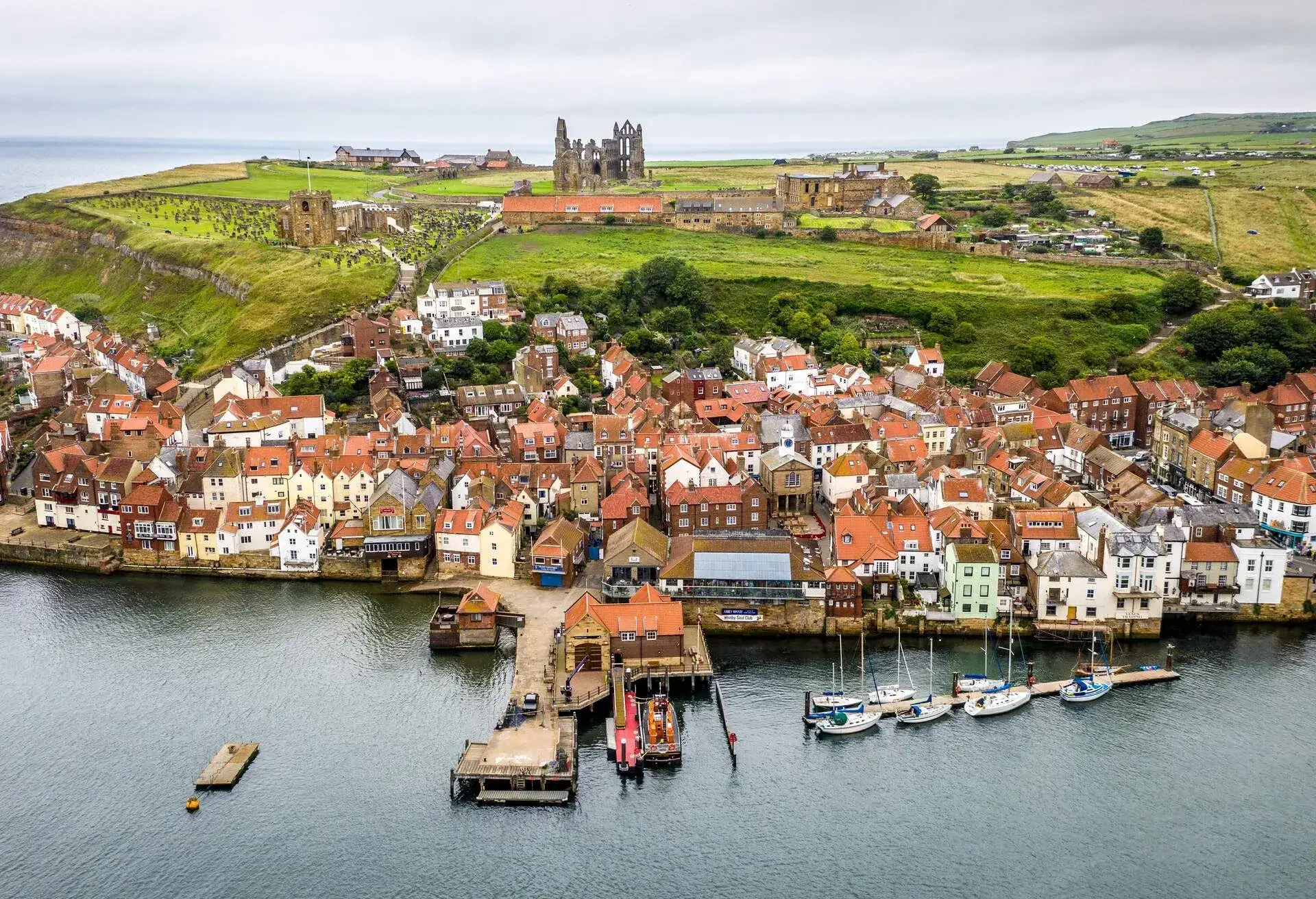
Overlooking the sea on the cliffs above Whitby in Yorkshire, this Abbey needs no introduction. First founded in 657AD, the original monastery here was laid waste to by Danish Vikings in the 9th century and it is the ruins of the second monastery, built in the 13th century, that we all know today. So, while most of us have an image of this Abbey indelibly burnt into our imaginations the majority of us have never actually been here. We can’t recommend seeing it in real life enough.
Important from a literary perspective, Whitby Abbey is where the Count first came ashore in the guise of a large dog and climbed the 199 steps to the abbey in Bram Stoker’s ‘Dracula’. To really get your teeth into the atmosphere of the place, have a read of the book or watch one of the countless film adaptations (Bela Lugosi or Christopher Lee’s versions for our money) before visiting.
When to go: Halloween.
How to get there: Located a 30-minute drive from Scarborough and 45 minutes from Middlesbrough. You can get the bus to Whitby from Middlesbrough train station.
Wistman’s Woods, Devon: Devonitely a great place to visit
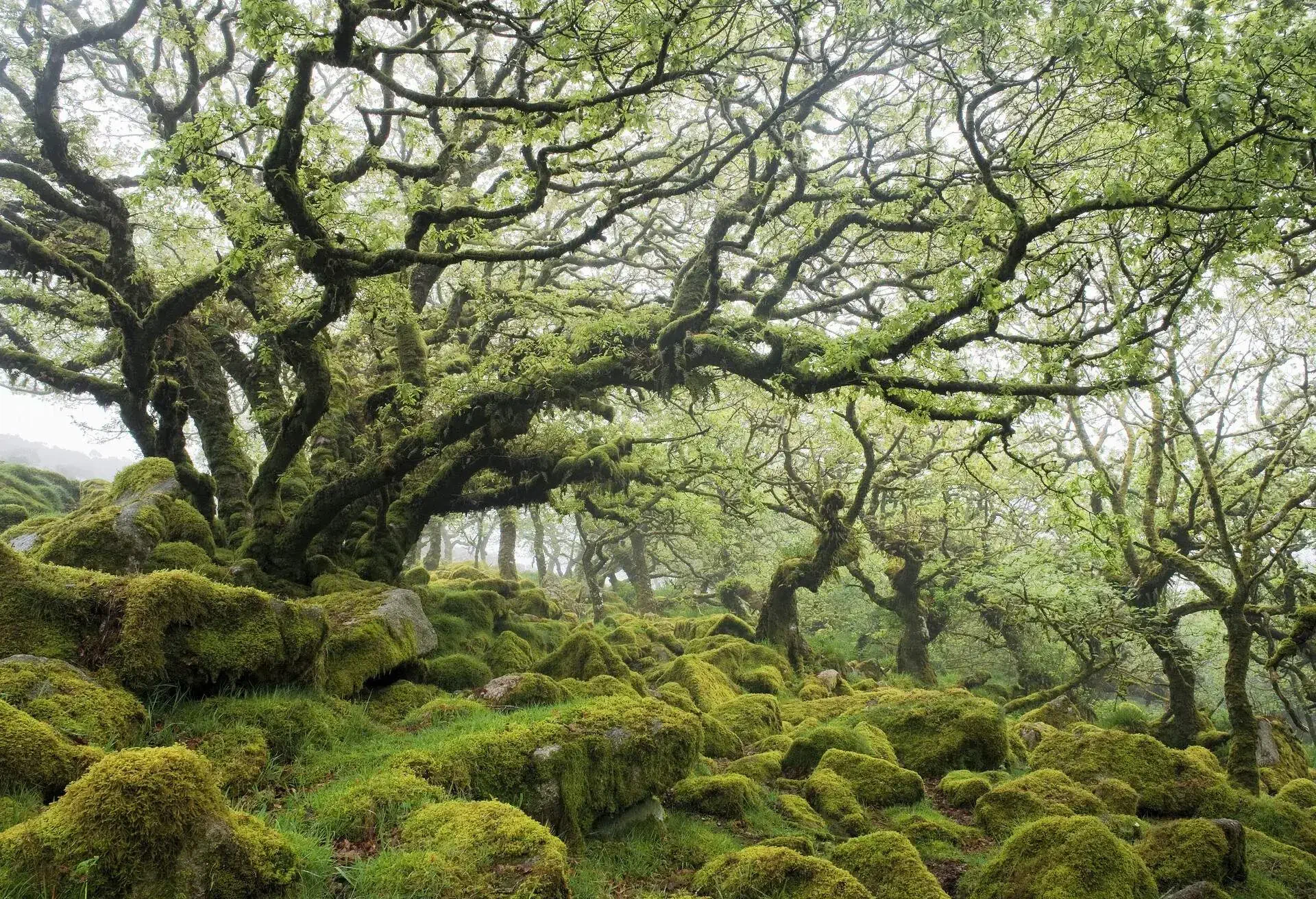
These woods are the stuff of fairytales. Open all year round but best in spring or winter, the wild combination of Burtonesque trees and mosses and lichen that adorn the boulders and trees in this part of Devon are a wonder to behold. It is recommended that travellers to this remote woodland have some experience with hiking but if you don’t maybe this is the inspiration you need to start a new hobby.
When to go: The summer (before and after the school holidays) when it’s less slippery.
How to get there: Take the A38 from the M5. Exeter, Plymouth, and Torquay are the nearest major train stations.
Looking for more staycation inspiration? Check out the 10 best UK holidays for families.

